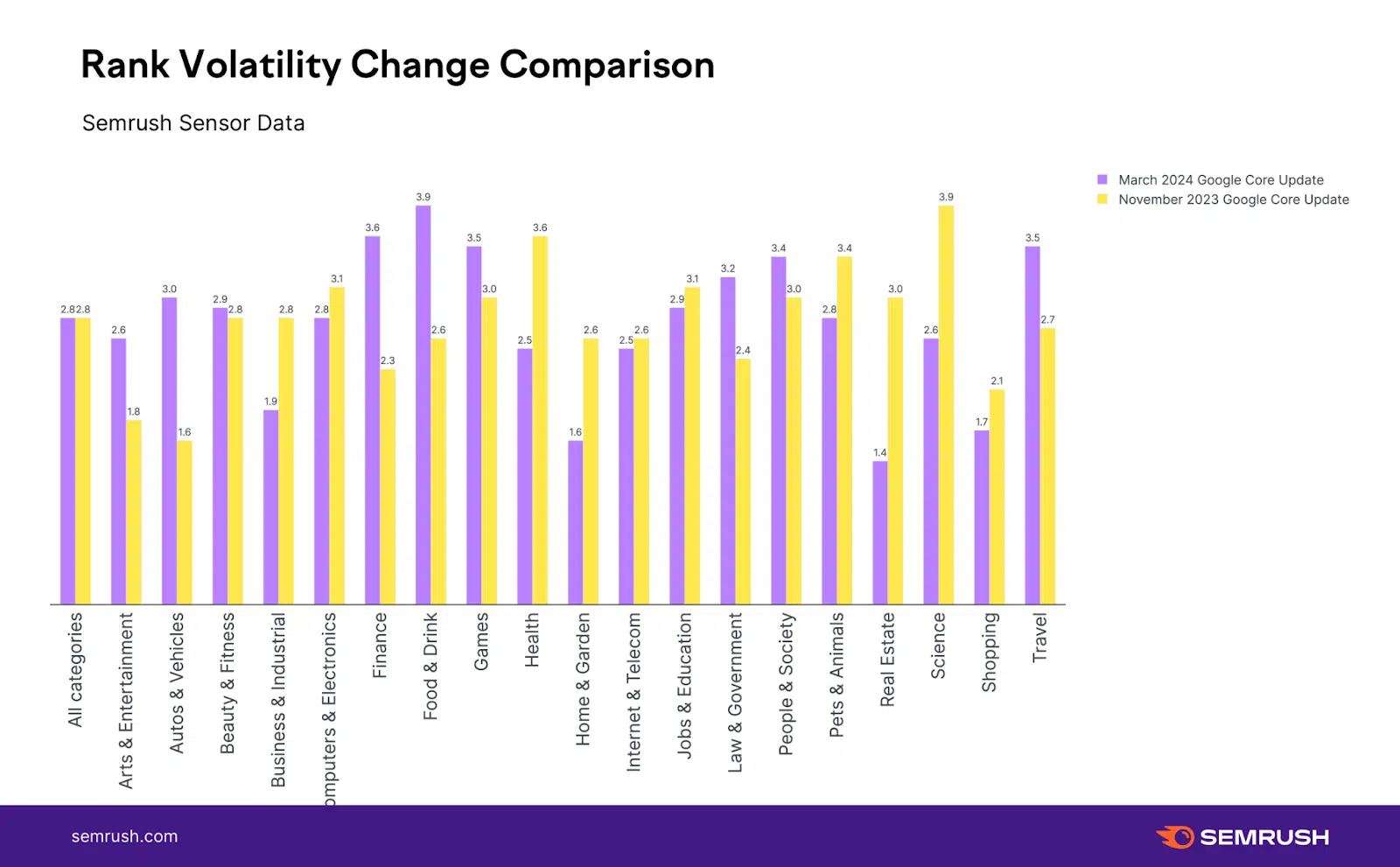Google’s March 2024 core update will palms down be one of the vital talked-about search engine optimisation subjects of the yr, if not the previous couple of years.
There’s a lot across the replace, from its size to the demise of the useful content material replace (HCU) to the entire high quality points on the SERP (speaking about you, Reddit).
There may be going to be rather a lot stated about this replace. Right here are some things I needed to share based mostly on knowledge Semrush shared with me, scouring by a whole lot of SERPs and searching on the rating patterns together with the websites themselves.
To be clear: none of that is definitive. The next evaluation is what I’ve seen and my interpretations.
1. Analyzing this replace is tough
Analyzing the Google March 2024 core replace tough for a lot of causes. Even simply understanding what occurred when it comes to the HCU and integration (or lack thereof) into the core is an entire basket of confusion for varied causes.
The opposite elephant within the room is how long the update took to roll out, which presents a heap of problems in comparison with conventional knowledge.
For instance, one of many “metrics” device suppliers present is the extent of “peak volatility.”
As I’ve talked about at varied occasions (together with SMX Subsequent 2023), this metric is usually the least telling when gauging the affect of an algorithm replace, however it may nonetheless assist paint the general image.
I’d say, on this case, it’s virtually totally irrelevant.
When you look under, the degrees of peak rank volatility seen throughout the March 2024 core replace are literally decrease than what Semrush tracked again throughout the November 2023 core replace.


Surprising? Probably not.
The March 2024 core replace was a really totally different replace. It wasn’t a few fast week or so burst of intense algorithmic exercise – it was a protracted collection of many moments of algorithmic depth.
Taking a look at a “peak” second in time (in our case, one out of 45 days) just isn’t how this replace needs to be analyzed.
The identical applies to a different metric that’s typically fairly telling: volatility change. This knowledge appears on the ranges of rank fluctuations throughout a baseline interval (a interval of relative calm) and compares them to the extent of fluctuation seen throughout the replace.
Wanting under, it seems the March 2024 core replace and the November 2023 core replace present the very same quantity of relative change per Semrush:


Right here, too, the metric depends on evaluating one second in time to a different second. With the March 2024 core replace, it’s not about particular algorithmic moments that may be analyzed however the entire shebang.
All of it makes gauging the affect of Google’s March 2024 core replace far tougher than common (and it’s normally very tough).
2. Large motion on the backside half of the SERP throughout the online
I will need to have checked out round 300 SERPs and the rating patterns of the highest 20 outcomes over the course of the whole replace.
One in every of my early observations was that there was a ton of motion towards the underside of “web page one of many SERP” however the high outcomes didn’t appear to see any elevated volatility relative to different updates I’ve analyzed.
That’s to not say websites weren’t impacted by key rating losses on the high of the SERP. I’m saying that, general, I anticipated to see extra motion on the very high of the SERP.
(When you’re screaming, “No, I’ve seen loopy rating swaps on the high of the SERP you idiot!” you’re not unsuitable – I’ll get to it.)
This evaluation appears to be corroborated by the information Semrush offered me.
If we have a look at the share of URLs rating high 10 post-update that previous to the replace didn’t crack the highest 20 you’ll see a disparity between the March 2024 core replace and the November 2023 core replace:


In November, 6.46% of the URLs rating within the high 10 got here from past place 20. That quantity jumps noticeably to 9.38% in March.
To me, that is extra telling than peak volatility or volatility change. It’s the evaluation of the place issues have been and the place they ended up over the course of the replace. It’s not simply taking a look at a one-shot second in time.
It additionally helps to see how drastic the rank volatility was and whether or not Google was actually rewarding what it hadn’t identified to reward earlier than.
That stated, the identical sample doesn’t maintain true when wanting on the high 5 outcomes:


Among the many high 5 outcomes, the hole between the March 2024 core replace and the November 2023 core replace is way much less vital.
This could level to the March 2024 core replace not being disproportionately potent relative to different core updates the place it issues most – the very high of the SERP. (Once more, when taking a look at it by this very particular lens).
It additionally factors to what I noticed and talked about earlier than – the replace was heavy-handed towards positions 6-10.
Beware – this can be a horizontal knowledge evaluation that was meant to attempt to sweep throughout the online – it’s very normalized. We nonetheless must dig a bit extra “vertically” and that’s a part of what makes analyzing this replace so arduous.
Get the day by day e-newsletter search entrepreneurs depend on.
3. The combination knowledge solely tells one a part of the story
With this replace specifically, I believe you may’t simply sweep throughout the online and have a look at the top-level knowledge. It’s, in a bizarre method, too normalized.
Wanting on the net horizontally consists of websites that misplaced and gained rankings however principally consists of websites that didn’t do a lot of something.
To get a greater understanding of the replace, it’s important to hone in on who was impacted and the character of that affect. That’s a extra vertical and qualitative evaluation.
From what I see (once more, it’s simply what I see, and it’s anecdotal at that), the March 2024 core replace had a chunk to it that you just don’t at all times see with a core replace.
Beneath is a web site that slowly began to see progress in September 2023 (satirically proper across the September 2023 useful content material replace) and actually took off in This autumn 2023 (suspiciously so, however I’ve not dug sufficient to say that with any confidence).
The March 2024 core replace destroyed it.


Since I discussed the September 2023 HCU, under is a web site that noticed a rating reward with the August 2023 core replace however a loss with the September 2023 HCU a month later.
The March 2024 core replace all however completed it off.


There does appear to be a little bit of a sample with websites getting hit by the September 2023 HCU and seeing subsequent losses with the March 2024 core replace:


My private idea is that no, Google didn’t throw away the HCU. It makes zero sense to me that they invested so closely to create the assemble solely to throw it within the trash can.
What I personally assume occurred is the classifier utilized by the HCU was constructed upon and serves as the muse of the now multifaceted method Google algorithmically assesses helpfulness.
Consider it just like the Mannequin T. No, the Mannequin T just isn’t produced anymore, however the course of used to mass-produce it serves as the idea and basis for mass-producing the automobiles we drive at this time.
For the file, not all websites bought hit; some bought rewarded. Right here’s a web site’s informational content material folder getting a large uplift with the March 2024 core replace:


So how ‘massive’ was the March 2024 core replace?
Making an attempt to measurement up any algorithm replace is such a precarious job. All of the extra so with the March 2024 core replace.
I hate to make use of the age-old search engine optimisation cliche, but it surely relies upon. It is dependent upon the way you have a look at it.
Do you outline the affect of the March 2024 core replace by its attain throughout the online as an entire? In that case, there are indications that it was stronger than your typical replace however not definitively so.
Nevertheless, should you outline the affect of the March 2024 core replace by its capacity and tendency to be heavy-handed, then the March 2024 core replace, by all accounts, appears to have had some further chunk.
My private take: there was one thing totally different about this replace. When you mix all of it, the additional chunk the replace had in negatively impacting websites, the additional rank volatility seen on the sixth – tenth rank positions, and so forth., paints an image of what’s a really “distinctive” replace.
Opinions expressed on this article are these of the visitor creator and never essentially Search Engine Land. Workers authors are listed here.

